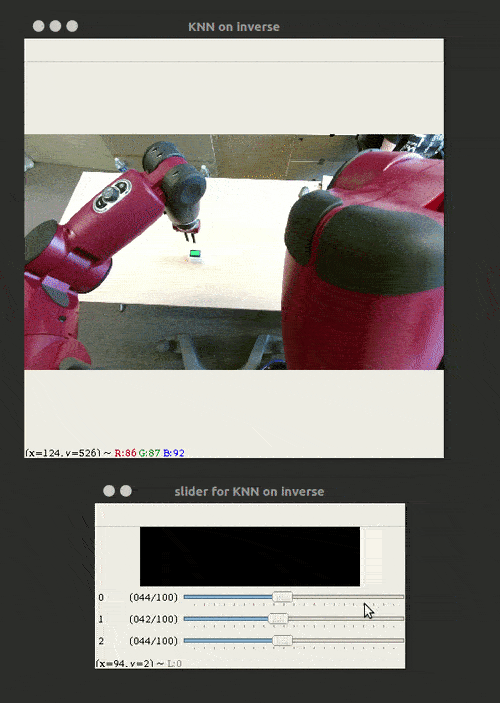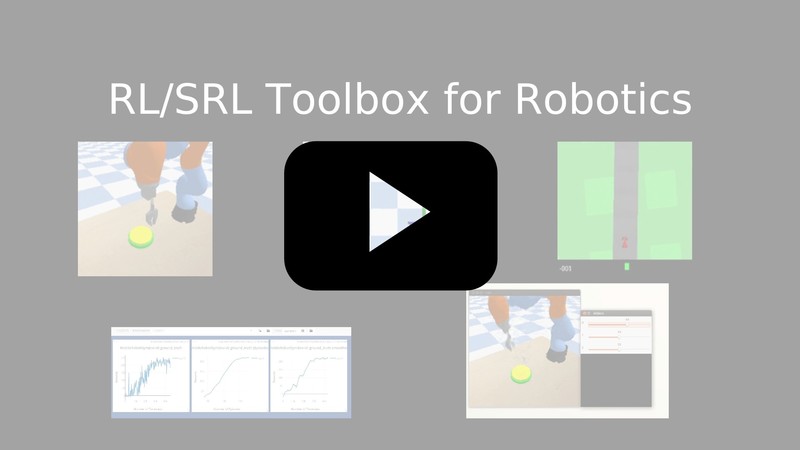araffin / Srl Zoo
Programming Languages
Projects that are alternatives of or similar to Srl Zoo
State Representation Learning Zoo with PyTorch (part of S-RL Toolbox)
A collection of State Representation Learning (SRL) methods for Reinforcement Learning, written using PyTorch.

SRL Zoo Documentation: https://srl-zoo.readthedocs.io/
S-RL Toolbox Documentation: https://s-rl-toolbox.readthedocs.io/
S-RL Toolbox Repository: https://github.com/araffin/robotics-rl-srl
Available methods:
- Autoencoder (reconstruction loss)
- Denoising Autoencoder (DAE)
- Forward Dynamics model
- Inverse Dynamics model
- Reward prediction loss
- Variational Autoencoder (VAE) and beta-VAE
- SRL with Robotic Priors + extensions (stereovision, additional priors)
- Supervised Learning
- Principal Component Analysis (PCA)
- Triplet Network (for stereovision only)
- Combination and stacking of methods
- Random Features
- [experimental] Reward Prior, Episode-prior, Perceptual Similarity loss (DARLA), Mutual Information loss
Related papers:
- "Decoupling feature extraction from policy learning: assessing benefits of state representation learning in goal based robotics" (Raffin et al. 2018) https://arxiv.org/abs/1901.08651
- "S-RL Toolbox: Environments, Datasets and Evaluation Metrics for State Representation Learning" (Raffin et al., 2018) https://arxiv.org/abs/1809.09369
- "State Representation Learning for Control: An Overview" (Lesort et al., 2018), link: https://arxiv.org/pdf/1802.04181.pdf
Documentation
Documentation is available online: https://srl-zoo.readthedocs.io/
Installation
Please read the documentation for more details, we provide anaconda env files and docker images.
Learning a State Representation
To learn a state representation, you need to enforce constrains on the representation using one or more losses. For example, to train an autoencoder, you need to use a reconstruction loss. Most losses are not exclusive, that means you can combine them.
All losses are defined in losses/losses.py. The available losses are:
- autoencoder: reconstruction loss, using current and next observation
- denoising autoencoder (dae): same as for the auto-encoder, except that the model reconstruct inputs from noisy observations containing a random zero-pixel mask
- vae: (beta)-VAE loss (reconstruction + kullback leiber divergence loss)
- inverse: predict the action given current and next state
- forward: predict the next state given current state and taken action
- reward: predict the reward (positive or not) given current and next state
- priors: robotic priors losses (see "Learning State Representations with Robotic Priors")
- triplet: triplet loss for multi-cam setting (see Multiple Cameras section in the doc)
[Experimental]
- reward-prior: Maximises the correlation between states and rewards (does not make sense for sparse reward)
- episode-prior: Learn an episode-agnostic state space, thanks to a discriminator distinguishing states from same/different episodes
- perceptual similarity loss (for VAE): Instead of the reconstruction loss in the beta-VAE loss, it uses the distance between the reconstructed input and real input in the embedding of a pre-trained DAE.
- mutual information loss: Maximises the mutual information between states and rewards
All possible arguments can be display using python train.py --help. You can limit the training set size (--training-set-size argument), change the minibatch size (-bs), number of epochs (--epochs), ...
Datasets: Simulated Environments and Real Robots
Although the data can be generated easily using the RL repo in simulation (cf Generating Data), we provide datasets with a real baxter:
Examples
You can download an example dataset here.
Train an inverse model:
python train.py --data-folder data/path/to/dataset --losses inverse
Train an autoencoder:
python train.py --data-folder data/path/to/dataset --losses autoencoder
Combining an autoencoder with an inverse model is as easy as:
python train.py --data-folder data/path/to/dataset --losses autoencoder inverse
You can as well specify the weight of each loss:
python train.py --data-folder data/path/to/dataset --losses autoencoder:1 inverse:10
Please read the documentation for more examples.
Running Tests
Download the test datasets kuka_gym_test and kuka_gym_dual_test and put it in data/ folder.
./run_tests.sh
Troubleshooting
CUDA out of memory error
- python train.py --data-folder data/staticButtonSimplest
RuntimeError: cuda runtime error (2) : out of memory at /b/wheel/pytorch-src/torch/lib/THC/generic/THCStorage.cu:66
SOLUTION 1: Decrease the batch size, e.g. 32-64 in GPUs with little memory.
SOLUTION 2 Use simple 2-layers neural network model python train.py --data-folder data/staticButtonSimplest --model-type mlp

